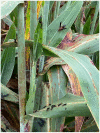Insect Feeding on Sorghum bicolor Pollen and Hymenoptera Attraction to Aphid-Produced Honeydew
- PMID: 36555062
- PMCID: PMC9780982
- DOI: 10.3390/insects13121152
Insect Feeding on Sorghum bicolor Pollen and Hymenoptera Attraction to Aphid-Produced Honeydew
Abstract
Pollinators are declining globally, potentially reducing both human food supply and plant diversity. To support pollinator populations, planting of nectar-rich plants with different flowering seasons is encouraged while promoting wind-pollinated plants, including grasses, is rarely recommended. However, many bees and other pollinators collect pollen from grasses which is used as a protein source. In addition to pollen, Hymenoptera may also collect honeydew from plants infested with aphids. In this study, insects consuming or collecting pollen from sweet sorghum, Sorghum bicolor, were recorded while pan traps and yellow sticky card surveys were placed in grain sorghum fields and in areas with Johnsongrass, Sorghum halepense to assess the Hymenoptera response to honeydew excreted by the sorghum aphid (SA), Melanaphis sorghi. Five genera of insects, including bees, hoverflies, and earwigs, were observed feeding on pollen in sweet sorghum, with differences observed by date, but not plant height or panicle length. Nearly 2000 Hymenoptera belonging to 29 families were collected from grain sorghum with 84% associated with aphid infestations. About 4 times as many Hymenoptera were collected in SA infested sorghum with significantly more ants, halictid bees, scelionid, sphecid, encyrtid, mymarid, diapriid and braconid wasps were found in infested sorghum plots. In Johnsongrass plots, 20 times more Hymenoptera were collected from infested plots. Together, the data suggest that sorghum is serving as a pollen food source for hoverflies, earwigs, and bees and sorghum susceptible to SA could provide energy from honeydew. Future research should examine whether planting strips of susceptible sorghum at crop field edges would benefit Hymenoptera and pollinators.
Keywords: agroecosystem; beneficial insects; carbohydrate; conservation biological control; pollen; pollinivore.
Conflict of interest statement
The authors declare no conflict of interest.
Figures



References
-
- McGregor S.E. Insect Pollination of Cultivated Crop Plants. Agricultural Research Service, US Department of Agriculture; Washington, DC, USA: 1976.
-
- Altierr M., Schmidt L. Cover crops affect insect and spider populations in apple orchards. Calif. Agric. 1986;40:15–17.
-
- Andow D.A. Vegetational diversity arthropod population. Annu. Rev. Entomol. 1991;36:561–566. doi: 10.1146/annurev.en.36.010191.003021. - DOI
Grants and funding
LinkOut - more resources
Full Text Sources

